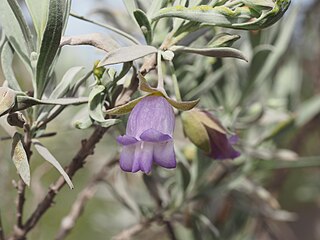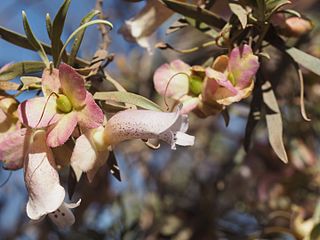
Eremophila youngii is a flowering plant in the figwort family, Scrophulariaceae and is endemic to Western Australia. It is a dense, erect shrub with many of its parts covered with a layer of grey to yellowish-grey scales and with pink, purple or red flowers.

Eremophila clarkei, commonly known as turpentine bush, is a flowering plant in the figwort family, Scrophulariaceae and is endemic to Western Australia, South Australia and the Northern Territory. It is a shrub which is variable in form, but usually with narrow leaves and white or pale pink flowers. It is similar to Eremophila georgei and Eremophila granitica.

Eremophila maitlandii, commonly known as Shark Bay poverty bush, is a flowering plant in the figwort family, Scrophulariaceae and is endemic to Western Australia. It is a silvery-grey shrub with linear leaves and lilac-coloured to light purple flowers and is common in coastal areas between Shark Bay and Carnarvon.

Eremophila fraseri, commonly known as burra or jilarnu, is a flowering plant in the figwort family, Scrophulariaceae and is endemic to Western Australia. It is a shrub or small tree with all above-ground parts of the plant, apart from the petals, sticky and shiny due to the presence of a large amount of resin. The petals are coloured white, cream, pink and brown.
Eremophila cordatisepala is a flowering plant in the figwort family, Scrophulariaceae and is endemic to areas of Queensland and the Northern Territory in Australia. It is a small grey shrub with purple to lilac-coloured flowers which have heart-shaped sepals at their base.
Eremophila fallax is a flowering plant in the figwort family, Scrophulariaceae and is endemic to Australia. It is a densely-foliaged shrub with leaves which have a hooked tip and with blue to violet flowers. It occurs in South Australia and Western Australia. Without flowers, this species closely resembles Eremophila deserti but that species has 5 stamens and its fruits are a different shape.

Eremophila jucunda is a flowering plant in the figwort family, Scrophulariaceae and is endemic to Western Australia. It is a small to medium-sized shrub with hairy branches and leaves, lance-shaped to egg-shaped leaves and cream-coloured, lilac or purple flowers.

Eremophila margarethae, commonly known as sandbank poverty bush, is a flowering plant in the figwort family, Scrophulariaceae and is endemic to Western Australia. It is a low, spreading shrub with grey leaves, flowers a shade of pink or purple, common in central areas of Western Australia.

Eremophila mirabilis is a flowering plant in the figwort family, Scrophulariaceae and is endemic to Western Australia. It is a shrub with narrow leaves, brightly coloured sepals and petals growing in two widely separated areas.

Eremophila muelleriana, commonly known as round-leaved eremophila, is a flowering plant in the figwort family, Scrophulariaceae and is endemic to Western Australia. It is an open shrub with light-coloured new foliage, broad leaves and deep purple-violet flowers.

Eremophila phyllopoda is a flowering plant in the figwort family, Scrophulariaceae and is endemic to Western Australia. It is an erect or spreading shrub, sometimes round or flat-topped with sticky, hairy leaves and flowers ranging in colour from pink or lilac to purple.

Eremophila platycalyx is a flowering plant in the figwort family, Scrophulariaceae and is endemic to Western Australia. It is a shrub or small tree with its branches and leaves covered with a layer of matted hairs, although the hairs are sometimes obscured by resin. The shape of the leaves is variable, depending on subspecies, the sepals are often brightly coloured and the petals are cream-coloured, sometimes spotted on the outside. Two subspecies have been described but others have been discovered although not as yet formally described.
Eremophila prolata is a flowering plant in the figwort family, Scrophulariaceae and is endemic to Western Australia. It is an erect shrub with a rounded top, prominently ridged, hairy branches, narrow leaves and white to deep lilac-coloured flowers.

Eremophila recurva is a flowering plant in the figwort family, Scrophulariaceae and is endemic to Australia. It is a shrub with hairy grey leaves, large grey sepals and blue, mauve or lilac flowers.

Eremophila reticulata is a flowering plant in the figwort family, Scrophulariaceae and is endemic to Western Australia. It is a dense shrub with egg-shaped leaves, colourful sepals and white or pink flowers.

Eremophila rigida is a flowering plant in the figwort family, Scrophulariaceae and is endemic to Western Australia. It is an erect, rigid shrub with thick, hairy, rigid leaves and pale yellowish-cream flowers.

Eremophila saligna, commonly known as willowy eremophila, is a flowering plant in the figwort family, Scrophulariaceae and is endemic to Western Australia. It is an upright shrub with narrow, serrated leaves, cylindrical flowers and cream to white petals.

Eremophila santalina is a flowering plant in the figwort family, Scrophulariaceae and is endemic to South Australia. It is an erect, glabrous shrub with thin branches, flexible leaves and white or cream-coloured flowers which sometimes have a slight pinkish-purple tinge.

Eremophila spathulata, commonly known as spoon-leaved eremophila, is a flowering plant in the figwort family, Scrophulariaceae and is endemic to Western Australia. It is a shrub with many tangled branches, stiff, grey, spoon-shaped leaves, reddish-purple sepals and blue, pink or violet petals.
Eremophila verrucosa is a flowering plant in the figwort family, Scrophulariaceae and is endemic to South Australia. It is an erect, broom-shaped shrub with its leaves and branches covered with yellow-grey scales and lilac to purple flowers.















